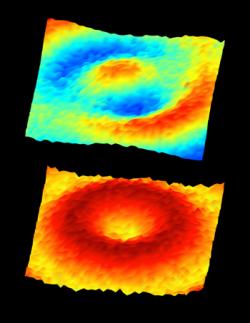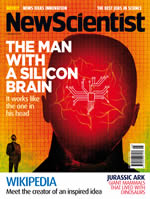
A scanning method that could prove crucial to the development of a practical quantum computer has been developed by US researchers.
Quantum computers process information in the form of quantum bits, or qubits. These act like the bits in conventional computers but, instead of existing in one of two states, a qubit can exist in both states simultaneously.
This means a quantum computer can perform multiple calculations simultaneously. So far, only a handful of qubits have been used at a time to perform calculations in the laboratory. But if quantum computers can be scaled up, they should be able to perform incredibly tricky calculations in an instant.
Physicists at the University of California in Santa Barbra, US, have discovered a new way to check the quantum state of information stored inside a qubit. Knowing exactly what's going on inside makes designing error-checking for quantum computers possible. This is necessary because information encoded as a qubit degrades over time.
There are several competing approaches to quantum computing, the most advanced of which involves using ions trapped in an electromagnetic field. A way to accurately read the quantum state of these qubits already exists but some researchers doubt it will ever successfully scale up to make a practical device.
The error-checking method developed by the University of California team led by John Martinis involves a competing approach, which experts say could have far greater potential to scale up.
In their set-up, a qubit is created using a circuit including two superconducting metals separated by an insulating barrier. Passing a current through this component produces a qubit in the form of two energy levels in superposition, or both states simultaneously.
Reducing the energy barrier used to maintain this state of superposition "collapses its quantum waveform" into one of the two energy levels. But Martinis' team has found it can lower the energy barrier to a point just above the highest of the two energy levels, only partially collapsing the waveform. This is called a partial measurement.
Scanning the qubit using microwave radiation, and then fully removing the energy barrier can then reveal its state of superposition and document its collapse. In a functional quantum computer this could be used to inform error-correction measures on connected qubits in the same device.
"It's the dark horse of the quantum computing race," researcher Nadav Katz told New Scientist. He says the accurate measurement method could provide the race with a significant boost: "It suggests we will be able to use systems based on it to do computations."
As an added bonus the hardware required can be manufactured with the technology used to make conventional computer chips. Katz's team plans to test its scanning technique using a simple system involving just two qubits.
The breakthrough shows that competition is intensifying between different quantum computing schemes, says Tim Spiller, a quantum communications researcher at Hewlett-Packard's research laboratory in Bristol, UK.
"Ion traps are currently ahead," he told New Scientist. But the work carried out by Katz's team shows this lead is shrinking, he added: "This is a very promising result for this technology, which has more potential to scale up."
Journal reference: Science (vol 312 p 1498)



